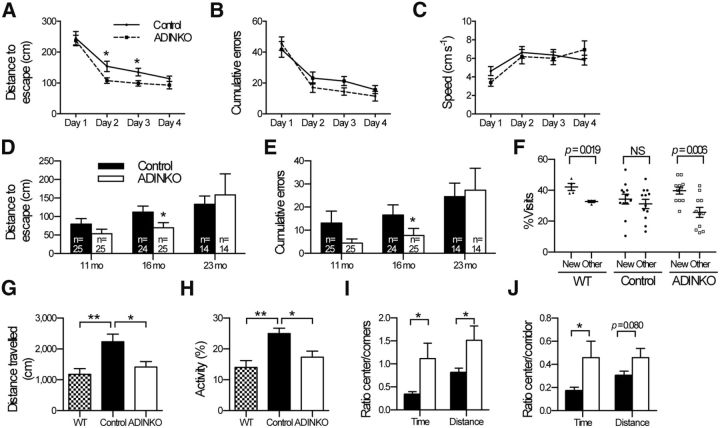Figure 5.
Neuron-specific IGF-1R inactivation in adult APP/PS1 mice improves spatial memory and reduces hyperactivity and anxiety-like behavior. A–E, Learning and memory assessed using Barnes maze. Sixteen-month-old females (n = 25 per group) were trained 4 times/d for 4 d. Training improved performance in all groups. Distance traveled to refuge box (A), cumulative error (B), and speed (C) are shown for each day. A, Repeated-measures ANOVA for distance over days revealed a significant main effect of neuronal IGF-1R knock-out in females (p = 0.042 for interaction, p < 0.001 for day; p = 0.035 for knock-out followed by multiple t test; *p < 0.05, mean ± SEM). D, E, Long-term retention was assessed on day 5. Distance traveled (D) and cumulative error (E) was evaluated as during acquisition. Number of mice is indicated in each bar. Mann–Whitney U test (*p < 0.05). F, Twenty-three-month-old females were tested in a two-trial Y-maze assay for short-term spatial memory, comparing visits to known (Other) versus unknown areas (New). Mean ± SEM and individual results of female control (n = 12) and female ADINKO mice (n = 11; paired Student's t test. G–J, Open-field test of 23-month-old female ADINKO (n = 12), controls (n = 13), and non-AD littermates (WT, n = 8). The WT group was included to validate tests. Total distance traveled (G) and time of active behavior (H) within a 10 min session. I, J, Ratios of the time spent and distance traveled in the center versus corners or corridor revealed decreased anxiety-like behavior of ADINKO mice. Student's t test, **p < 0.01, *p < 0.05; mean ± SEM.

